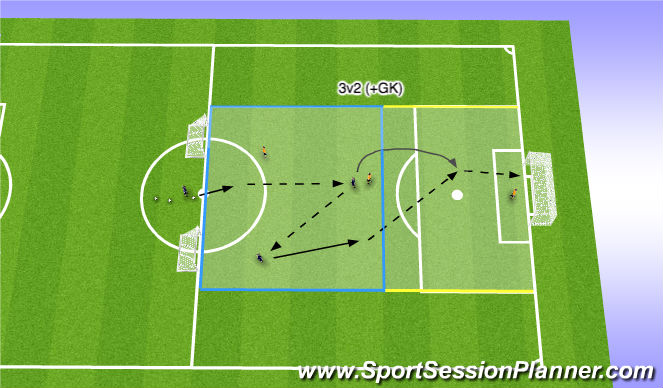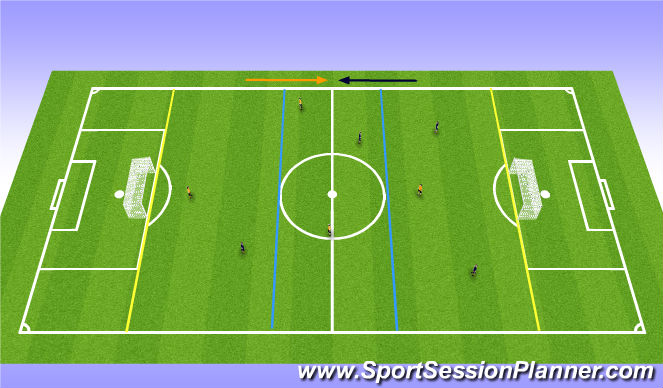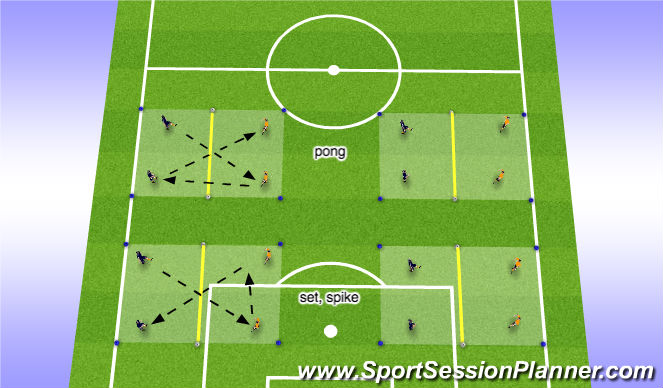Football/Soccer Session (Beginner): Term 1 / Week 6 - First Touch

Profile Summary

| Name: | Adam Davidson |
|---|---|
| City: | Sydney |
| Country: | Australia |
| Membership: | Adult Member |
| Sport: | Football/Soccer |
Description
Technical | First Touch
Tactical | Individual skill to create scoring chances
Psychological | Example
Session Objective | in this session I aim to improve our ability to (i) take a first touch forward when space is available ahead, and (ii) to take a safe first touch, away from pressure, when space ahead of us is tight. Our intention is to put players in game-like scenarios where they are exposed to cues/triggers for the actions mentioned above; ultimately it boils down to an understanding of when/where to play backwards, keep possession and circulate the ball VS when/where to receive to play forward.
Coaches, aim to keep coaching points short & simple. Go in, deliver your point, affect the players on the ball, around the ball and away from the ball, then get out. As often as possible look to coach on the run and let them play, however, if play needs to be stopped during tactical component and skill game, then address problems as follows: -
spot problem | stop play | correct using demonstration, guided discover and q&a | play is live off my touch "and we play".

See the guidance at the top of this page to understand why you are not seeing interactive Football/Soccer images.

Skill training: 3v1
Frame
Opposed first touch game that focuses on creating space & angles quickly to play FWD, when under defensive pressure.
Explanation
10x20 playing area with a central dividing line. 6 players; 3 players per team in each half. [NB: this game can be easily modified to suit 8-10 players]. Two small goals at opposite ends of the area. Orange play a firm pass into blue team; passing orange player travels across dividing line to apply pressure and regain possession. Blue team must complete 3 passes before playing it back across the dividing line to the orange team; passing blue player travels to apply pressure and regain possession.
Scoring | successfully completing 3 passes and playing a firm pass across the dividing line to the opposing team = 1 goal. A pressing player winning the ball and finishing in the opposition mini-goal = 1 goal. Play is restarted by the conceding team playing across the dividing line to the scoring team.
Coaching points
> lift your head before and after you receive the ball to check approaching pressure.
> be patient in possession; give it, get it back, start again, change your angle.
> awareness of where the defender is should dictate when / where you redirect the ball and shift it.
> Change the tempo and be unpredictable; sometimes play it quick and early / sometimes kill it, hold it, move with it, slow things down and then...speed it up!
> Movement to create space & angle to receive.
> Width and depth to stretch the playing area.

See the guidance at the top of this page to understand why you are not seeing interactive Football/Soccer images.

ST progression: 3v2(+GK) (15 mins)
Frame
Particular attention is paid to the idea of shifting the ball forward as a unit and, as often as possible making clever first touch decisions to creat goal-scoring opportunities.
Explanation
3v2 | 10x20 playing area with an 10x8 shooting zone at one end. A supply of 3 balls is placed at one end of the playing area. 3 attackers vs 2 defenders. No offside rule. Attacking team have 3 attempts to score 3 goals. Attackers must score off their first or second touch in the "shooting zone". Defenders can earn points by regaining possession and scoring in the small goals. A ball is dead when a goal is scored; dribble-ins / kick-ins if the ball leaves the playing area. When a ball is dead, play is restarted by the attacking team getting a new ball and starting a new attack. Rotate roles of players after all 3 balls are dead.
Coaching Points
> we're looking for the attacking team to provide good what? width and depth, good receiving angles, good first touch and various types of passes that suit the situation you're in.
> Let's say the orange have stolen the ball, and the blues win the ball back off them; let's walk through that. Ok, and already you're about to spread out - good. So, if the ball goes out to a team mate on the edge of the area, what are we looking for? Yeah, another little movement and rotation, just to clear space.
> so great, you've spread out wide, but as that ball travels you might just have to clear space to keep the passing options fresh.
> because the oranges might come out and press, the more we can move as the ball travels, the harder it will be for them to defend and get the ball back.
> speed up, slow down and show for the ball. If you don't get it spin out, move again, offer a different angle. Just moving isn't the same as showing for the ball and asking to receive.
> be patient in possession; pivot player controls the attack - give it, get it back, start again, change your angle, rotate if it's on.
> check shoulders for awareness of defenders, team mate and space.

See the guidance at the top of this page to understand why you are not seeing interactive Football/Soccer images.

Tactical component (20 mins)
Frame
A small-sided conditioned game to emphasise the importance of body shape/ positioning to play forward. Players receive feedback directly from the game itself and learn to become more aware of their surroundings and to react accordingly.
Explanation
2 large goals. 4v4 / 5v5 / 6v6. Short but wide pitch divided into thirds. Teams can only score in their attacking third and must shoot within 2 touches. No offside rule. Fly GK's = anyone can be GK at any time, but, they must shout "KEEPERS!" before using their hands.
Regression
1. first pass from the back third is free (you can't intercept). But then the next one is game on.
Coaching Points
> if unable to find a forward pass, can you find a team mate who might be able to?
> if it's tight in a small area and you can't squeeze through - you can come back out, pass and keep the ball - wait for the right opportunity to play forward and score.
> body shape will give you possibilities for different football actions - receive and play FWD / set back / play around the corner.
> receive back foot to play forward, receive front foot to protect the ball, set back and combine to play FWD.
> if I've lost my man and bought a yard or two of space, can I get it on my back foot? yeah, good players will take that forward and take the defender out of the game.
> what happens if he's very tight to me? yeah, I could move off him and set it for a team mate OR I sink in and play it around the corner like that.
> now, if I'm standing square I can't see what? what's behind me, and all of sudden all of those options I had before disappear.









 Play animation
Play animation Play step-by-step
Play step-by-step Repeat (toggle)
Repeat (toggle) Full Screen
Full Screen Pause
Pause Stop
Stop
Skill introduction (10 mins)
Frame
A fun but competitive technical game designed to improve first touch when passes are struck firmly. Players are challenged to redirect the ball with their first touch into space and set up an opportunity to play back with their second touch.
Explanation
10x6 playing area with a central dividing line. 4 players; 2 players per team in each half.
Pong with rotation | players pass to the opposite team to try and encourage them to make mistakes, passes are hit firmly and along the floor. Players rotate with their team mate after each pass. Each player has a maximum 2 touches (1 to control; 1 to play back across) - the player who receives the pass, IS the player who passes it back. If a team makes a mistake, 1 point is awarded to the opposition. A mistake is made if your first touch knocks the ball out of your own half / if a pass is wayward and off the ground. All passes must be below the knee (on the floor for beginners) and hit directly to one of the opposing players. The passes must be extremely firm to each other, with a lot of pace, but not erratic.
Progression
1. Set, Spike | As above, except with this caveat - both teams have a maximum of one touch per player per side (so a total of 2 touches for both teams in total). This means the receiver must lay off the pass to his partner (with one touch) at a good angle and distance for him to play the ball back to the opponents (in one touch). Receiver sets it, team mate spikes it.
2. Create challenges and competition e.g. first team to 6 points wins / teams must win by 2 clear points.
Coaching points
> quality of control; first touch should allow you to step into your pass / lay-off in front of team mate.
> we have to learn how to deal with bad passes; adaptability, variability in touches & passes.
> areas of the foot to receive and strike.
> use the whole area to create more space and time.
> complimentary movement; if one moves here, does one move there to support.